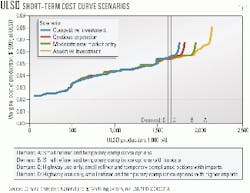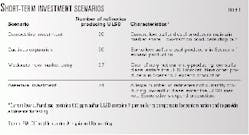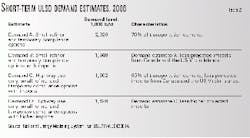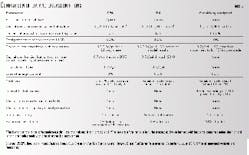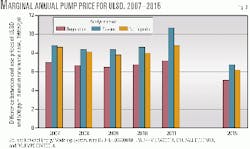Although implementation of the ultralow sulfur diesel rule (ULSD) may provoke a tight diesel market in the short term, refiners will increase supply to meet demand in the long term, says a recent report by the US Energy Information Administration.
The EIA conducted a study to analyze the effects on diesel price and supply of reducing sulfur in US highway diesel by 97%, a final rulemaking which was signed by former Pres. Clinton in December 2001.
The final rulemaking on Heavy-Duty Engine and Vehicle Standards and Highway Diesel Fuel Sulfur Control Requirements aims to reduce nitrogen oxides (NOx) and particulate matter (PM) emissions from diesel-run engines and vehicles. Starting June 1, 2006, diesel in terminals must have no more than 15-ppm sulfur. Retailers and wholesalers have until Sept. 1, 2006.
Through May 2010, small refiners, who produce up to 20% of US diesel fuel, may continue to meet the current 500-ppm specification for sulfur via temporary compliance options.
To comply with these 15-ppm specifications, diesel via pipelines must have a lower than 10-ppm sulfur level to avoid contamination from higher sulfur products in the system and to provide a tolerance for testing.
The EIA looked at two analyses: a short-term analysis during the transition to ULSD in 2006 and a midterm analysis from 2007 to 2015.
Short-term effects
The EIA generated cost curves to show demand and supply in 2006 for Petroleum Administration for Defense Districts (PADDs) I-IV (Fig. 1). Fig. 2 shows the breakdown of PADD regions in the US.
The short-term analysis did not include PADD V because supply concerns are less of an issue in the transition period and the requirements for California Air Resources Board diesel make the PADD V market different from those in PADDS I-IV.
Table 1 briefly defines the four refinery investment scenarios shown in the cost curves: the competitive investment, the cautious expansion, the moderate new market entry, and the assertive investment.
The EIA based ULSD production costs on refinery size, feed sulfur contents, fraction of cracked stocks in the feed (which are more difficult to treat), feed boiling range, and fraction of highway diesel produced. The assumed return on investment (ROI) was 5.2% after taxes, consistent with EPA's assumed 7% before-tax ROI.
Costs did not take sulfur credit trading into account because the extent of this occurrence is uncertain. Credit trading would reduce costs, however.
At the volumes needed to meet demand, the EIA estimated costs at 5.4-6.8¢/gal. These estimates do not include additional costs for distribution, estimated at 1.1¢/gal in the midterm analysis.
The EIA points out that these costs could be sharply higher if supply falls short of demand. The behavior of refiners is uncertain, said the report, because it is influenced by their expectation of what others will do.
Short-term demand
Table 2 lists demand scenarios estimated by the EIA.
Demand A (small refiner and temporary compliance options) represents 80% of estimated demand for transportation distillate for highway and nonroad uses in PADDs I-IV in 2006 (excluding production by small refiners who can request waivers to delay production until 2010). Demand B (small refiner and temporary compliance options with imports) assumes that imports from Canada and the Virgin Island will continue at historical levels.
Demand C (highway use only, small refinery and temporary compliance options with imports) assumes that ULSD will be used only to meet highway transportation demand, that the temporary compliance option will further reduce this demand by 20%, and that imports will remain at historical levels.
Demand D (highway use only, small refinery and temporary compliance options with higher imports estimate) assumes a higher level of ULSD imports than Demand C.
Fig. 1 shows that the largest shortfall in supply, estimated at 264,000 b/d, will occur if Demand A (highest demand estimate) occurs in a competitive investment scenario (lowest production estimate). The largest surplus, which is 517,000 b/d, will occur if Demand D (lowest demand estimate) simultaneously occurs with the assertive investment scenario (highest production estimate).
Supply will be capable of meeting demand should Demands C or D occur. Demand B can only be met with either a moderate new market entry or assertive investment scenarios. Only an assertive investment scenario meets the demand required by Demand A.
Short-term sensitivity
The EIA assumed hydrotreater capital costs and ROI assumptions similar to those used in EPA's analysis.
If capital costs are 40% higher than assumed, the EIA report estimated that ULSD production will be 25,000-50,000 b/d lower and production costs will be 0.5-1.1¢/gal higher. When a 10% rather than a 5.2% after-tax ROI is assumed, the EIA projected a 40,000-66,000 b/d decrease in production and a 0.8-1.2¢/gal increase in cost.
These lower production numbers cause the moderate new market entry scenario to fall short of Demand B.
Midterm effects
The EIA used National Energy Modeling System (NEMS) Petroleum Market Module (PMM) to assess the impact of diesel sulfur regulations in 2007-2010. Unlike the short-term analysis, PMM provides multiyear scenarios and assumes that, in the long term, refiners will increase supply to meet demand.
The model treats 2007 as the first full year of the 80/20 requirement and 2011 as the first full year of 100% requirement. It treats PADD I and PADD V as separate regions and lumps PADDs II, III, and IV into one aggregated region.
The PMM studied a regulation case based on the same assumptions as EIA's regulatory impact analysis as well as eight sensitivity cases:
- A higher capital cost case.
- A 2/3 revamp case.
- A 10% downgrade case.
- A 4% efficiency loss case.
- A 1.8% energy loss case.
- A severe case.
- A no imports case.
- A 10% ROI case.
Except for the 10% ROI case, the cases assume an after-tax ROI of 5.2%.
The resulting values are relative to a reference case using the oil price and macroeconomic assumptions of the Annual Energy Outlook 2001 with some modifications to reflect more accurately the diesel fuel market. The EIA expects the peak differential to occur in 2011 when refiners must produce 100% ULSD.
Regulation case
The assumptions in the regulation case are based on those used by the EPA in its regulatory impact analysis of the rule, published in December 2000. Table 3 lists the specific assumptions used for the regulation case.
Mainly, the EIA assumed:
- Highway diesel at the refinery gate will contain a maximum 7-ppm sulfur.
- Revamping will be undertaken by 80% of refineries while 20% build new units.
- Sulfur contamination will cause 4.4% of the ULSD to be downgraded to a lower value product.
- The energy content on the ULSD will decline by 0.5% as a result of undercutting and severe desulfurization.
- No loss in vehicle fuel efficiency will occur.
Fig. 3 and Table 4 show that the marginal annual pump price for ULSD in the regulation case will be 6.5-7.2¢/gal between 2007 and 2011. In absolute terms, real marginal prices will be $1.29-1.35/gal in the regulation and severe cases from 2007 to 2011.
After 2011, the projected differential of marginal prices will decline as a result of lower distribution and capital investment costs. About 0.7¢/gal of the projected decline will result from full amortization of additional capital investments for distribution and storage of a second highway diesel fuel. The remainder of the drop in post-2011 will occur because refineries have completed the upgrades necessary for full compliance.
Refiners will invest $6.3-9.3 billion to meet full compliance with the ULSD rule through 2011.
Table 4 shows that through 2010, the regulation case projections for highway diesel consumption exceeds the reference case by up to 10,000 b/d, which can be attributed to the assumption of a 0.5% loss in energy content.
In 2011, according to the EIA report, the differential consumption will increase to 83,000 b/d because contaminated ULSD in the distribution system can no longer be downgraded to 500-ppm highway diesel and refiners must therefore make more ULSD.
Severe case
In the severe case, the EIA assumed:
- Capital costs of hydrotreaters will be 24% higher than the reference case and 33% higher than the regulation case.
- Revamping will be undertaken by two-thirds of refineries while the remainder builds new units.
- Sulfur contamination will cause 10% of the 15-ppm ULSD to be downgraded to a lower value product.
- The energy content on the ULSD will decline by 1.8% as compared to the regulation case.
- Aftertreatment technology on new vehicles beginning in 2010 will cause a 4% drop in vehicle-fuel efficiency. This loss will lessen as new technologies emerge.
As Table 4 shows, in the severe case, the US will consume up to 57,000 b/d of additional highway diesel between 2007 and 2010. The ULSD rule by itself accounts for an average of 9,000 b/d of additional consumption through 2010 and an average of 83,000 b/d after 2010.
The combined effects of these assumptions raise consumption by at least 30,000 b/d beyond that in the regulation case primarily as a result of energy losses and higher capital costs.
Another 283,000 b/d of consumption after 2010 results from energy losses, downgrading, and efficiency losses. The higher downgrade assumption accounts for a loss of 210,000 bbl of additional demand after 2010.
Investments related to ULSD in the severe case will total about $9.3 billion through 2011, $3 billion more than in the regulation case. Higher demand in the severe case generally results in marginal prices 1.7-1.9¢/gal higher than in the regulation case although costs are 3.5¢/gal higher in 2011.
No-imports case
The no-imports case assumes that no foreign imports of ULSD will be available.
This assumption is unlikely because Canadian refiners will probably move to US fuel standards at the same time as the US and provide imports. As well, the Hovensa LLC's refinery in the Virgin Islands should be able to supply imports to the US.
The greatest uncertainty for import availability is likely in the early days of the program, said the report, because foreign refiners may delay investment until the market outlook for ULSD is more certain.
This case assumes that no imports of ULSD are available and imports of highway diesel are reduced by 120,000-125,000 b/d between 2007 and 2015, relative to the reference case.
Domestic refineries must therefore produce more ULSD, resulting in marginal prices of 1.1-1.6¢/gal higher than in the regulation case. This will slightly dampen demand in the no imports case, relative to the regulation case.
10% ROI
The 10% return on investment case assumes an after-tax ROI higher than the 5.2% used in the previous sensitivity cases. At a rate of less than 10%, said the report, investors may hesitate to put money into the refining industry, especially for equipment designed for a new product.
This case had to be compared to an alternative base case since the regulation case assumed a 5.2% ROI. The resulting price differentials were 7.5-8.0¢/gal between 2007 and 2011. That is, 0.9¢/gal higher on average than with the 5.2% after-tax ROI case.
Regional prices
In the transitional years of the regulation case, regional refining costs will range from 4.8¢/gal in PADD V to 5.3¢/gal in the other regions. PADD I will have the highest costs, and PADD V will have the lowest costs.
Average marginal refining costs will narrow by about 0.5¢/gal in the post 2010-period, said the report, as refineries make incremental improvements to allow them to produce ULSD more efficiently.
Uncertainties
The report mentions several uncertainties that affect the transition to ULSD:
- The pace of engine, refinery, and pipeline testing technology development.
- The availability of personnel, thick-walled reactors, and reciprocating compressors.
- The behavior of ULSD in the oil pipeline system.
- Cost recovery by oil pipelines.
The new ULSD rule requires engine manufacturers to reduce emissions of NOx, PM, and hydrocarbons from model year 2007 heavy-duty diesel engines. Most engine manufacturers will install NOx adsorbers.
To date, no NOx adsorber system has proven feasible. Although they comply with standards using 7-ppm ULSD, the current systems show losses in fuel efficiency after 2,000 miles of operation.
On the refining side, research-focused departments and companies are developing many new desulfurization technologies, which include sulfur adsorption, biodesulfurization, sulfur oxidation, gas-to-liquids, and biodesulfurization. It is uncertain whether these technologies will make a significant contribution to meeting the ULSD rule in 2006.
Sulfur testing methods also need to be improved before the rule takes effect. The designated method, ASTM 6428-99, was developed for testing sulfur in aromatics and has not yet been adapted or evaluated for testing sulfur in diesel fuel. Most oil pipeline operators will need a test that can be performed online because degradation of ULSD may occur in 1 min.
Current instruments, however, do not have the adequate sensitivity, accuracy, and speed for the job. Today's machines require 5-10 min. to complete an analysis for a passing product stream. This is too long to allow a pipeline operator to make a correctional response if the material is off specification.
Resources may be scarce in the near future because refiners will share engineering and construction resources to install diesel hydrotreaters with those to install gasoline desulfurization units between 2004 and 2006. The EPA expects a start-up overlap of 26 gasoline units and 63 units in 2006.
Tight equipment supply may also hinder installation of diesel facilities.
Lead times for thick-walled reactors will be longer as a result of higher demand. Only one to two US companies can provide thick-walled reactors.
Reciprocating compressors will also be in tight supply because each diesel desulfurization project will require at least two reciprocating compressors. Excluding the former Soviet Union, there are only five manufacturers of reciprocating compressors in the world.
The amount of contamination that will occur in pipelines is another uncertainty. There is no experience in distributing ULSD in a non-dedicated transportation system.
Finally, oil pipeline carriers may file a new tariff rate for transporting diesel fuel to recover additional capital and operating costs to transport ULSD. Today, if an oil pipeline carrier is operating under the Federal Energy Regulatory Commission's commonly approved index method and applies its existing tariff rate to ULSD, there is no basis for the carrier to recover its incremental costs in the approved rate, said the report.

